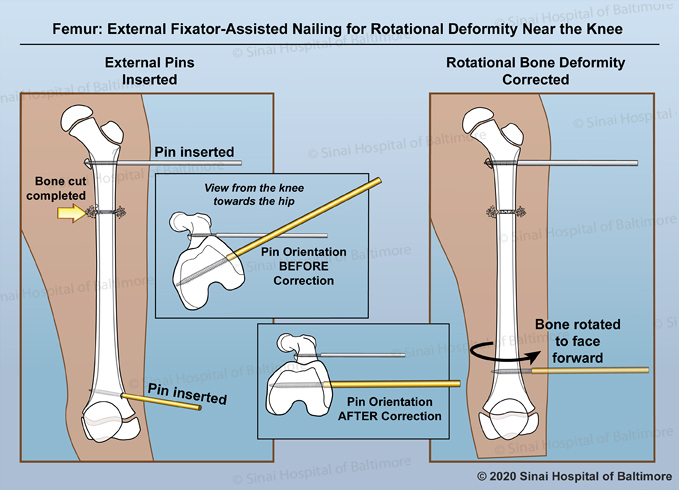Fixator-Assisted Nailing (FAN)
What is fixator-assisted nailing?
Fixator-assisted nailing or FAN is a surgical procedure where an external fixator is temporarily used to maintain optimal position of a bone while a nail or rod is placed inside the bone for longer-term stabilization and/or lengthening.
Our arm and leg bones are like hollow tubes, and one way to treat injuries and conditions of these bones is to place a nail, or rod, made of metal inside the tube to make it stable. An external fixator is a device held into the bone with a series of pins and connected like a scaffolding outside the bone.
When is fixator-assisted nailing a good option?
Fixator-assisted nailing is a good option when a bone needs to be cut as part of a treatment for a leg length difference or a bone deformity. In these cases, the bone must be cut in a procedure called as osteotomy. The bone cut then allows the surgeon to lengthen the bone with a special rod or to correct the angle of the bone. If lengthening is the goal, FAN is used to hold the bone above and below the bone cut while the rod that will be used to gradually lengthen the bone is put into place. If deformity correction is the goal, FAN is used to hold the bone above and below the bone cut while the rod that will hold the bone in its corrected angle is put into place.
Fixator-assisted nailing is also a good option when a bone is broken and can be treated with a rod placed inside the bone. The external fixator device can be used to hold the broken bone still while the rod is placed inside the bone by the surgeon.
What happens during the fixator-assisted nailing procedure?
The surgeon makes small incisions towards the top and bottom of the bone and drills pins into the bone away from the area needed for rod placement. The pins are then connected with a bar on the outside of the leg. If the surgeon is treating a leg length difference or deformity, he or she will also cut the bone while the external fixator holds the bone still. Another incision is made to insert the rod into the bone. If the bone being treated is the femur (thigh bone), the rod is inserted either close to the hip or through the knee. If the bone being treated is the tibia (shin bone), the rod is inserted through the knee. Once the rod is in place, the external fixation device is removed from the bone.


How long does the fixator-assisted nailing procedure last?
Depending on other procedures that may be done at the same time, the FAN procedure can take about one and one-half hours. In some instances where the bone is lengthened or a deformity of the bone is corrected, other procedures such as muscle lengthening or nerve decompressions can add additional time to the procedure.
How long must patients stay in the hospital after the fixator-assisted nailing procedure?
Length of hospital stay depends on several factors. However, one to two days is a good estimate. Prior to leaving the hospital, the patient must be able to move around while protecting the operated leg, generally putting only limited weight on the extremity. In order to ensure safety at time of discharge, physical therapy is required while in the hospital.
What are the benefits of fixator-assisted nailing?
Fixator-assisted nailing helps the surgeon treat long bones with great accuracy because the external fixator holds the bone in a good position while the rod is surgically placed within the bone. Additionally, the patient gets the benefits of the external fixator (improved accuracy) during surgery but does not have an external fixator on his or her leg once s/he wakes up.
